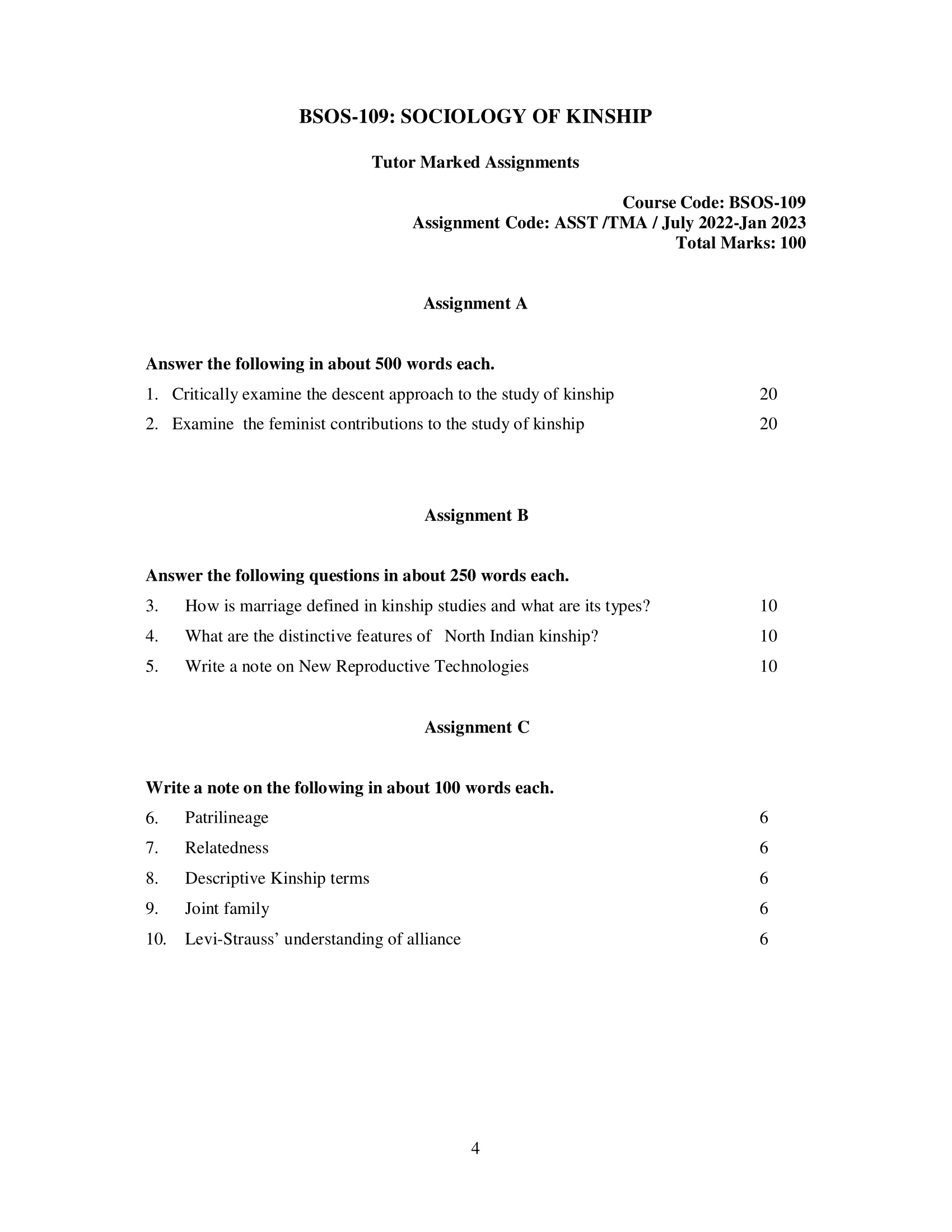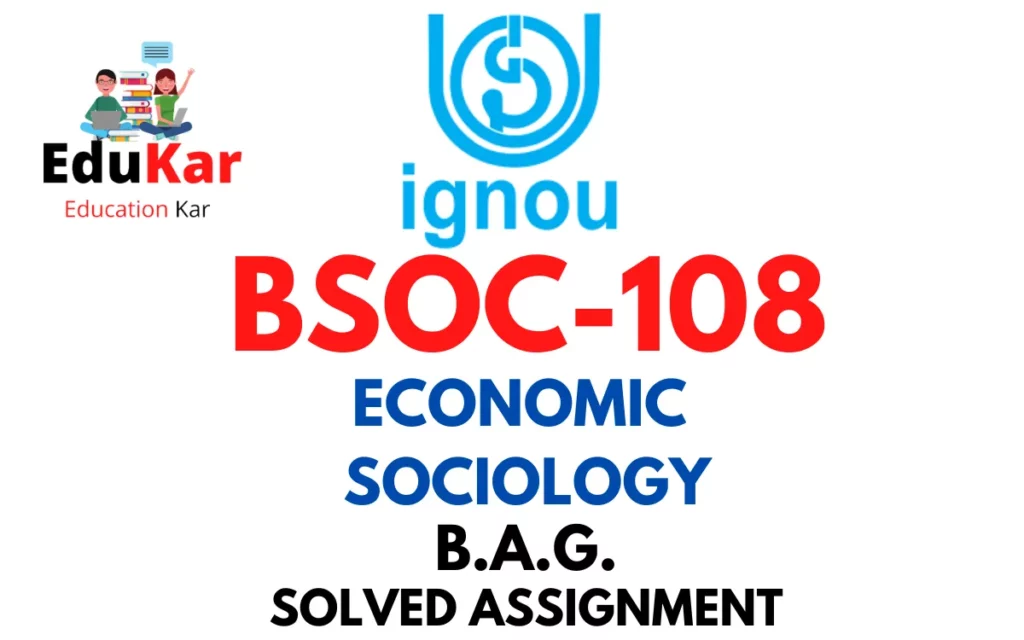Contents
- 1 Assignment A
- 2 Answer the following in about 500 words each.
- 3 1. Critically examine the descent approach to the study of kinship.
- 4 2. Examine the feminist contributions to the study of kinship.
- 5 Assignment B
- 6 Answer the following questions in about 250 words each.
- 7 3. How is marriage defined in kinship studies and what are its types?
- 8 4. What are the distinctive features of North Indian kinship?
- 9 5. Write a note on New Reproductive Technologies.
- 10 Assignment C
- 11 Write a note on the following in about 100 words each.
- 12 6. Patrilineage.
- 13 7. Relatedness.
- 14 8. Descriptive Kinship terms.
- 15 9. Joint family.
- 16 10. Levi-Strauss’ understanding of alliance.

| Title | BSOC-109: IGNOU BAG Solved Assignment 2022-2023 |
| University | IGNOU |
| Degree | Bachelor Degree Programme |
| Course Code | BSOC-109 |
| Course Name | SOCIOLOGY OF KINSHIP |
| Programme Name | Bachelor of Arts (General) |
| Programme Code | BAG |
| Total Marks | 100 |
| Year | 2022-2023 |
| Language | English |
| Assignment Code | ASST /TMA / July 2022-Jan 2023 |
| Assignment PDF | Click Here |
| Last Date for Submission of Assignment: | For June Examination: 31st April For December Examination: 30th September |

Assignment A
Answer the following in about 500 words each.
1. Critically examine the descent approach to the study of kinship.
Ans: The descent approach is a theoretical framework used in the study of kinship that emphasizes the importance of tracing ancestry and descent in understanding the social organization of societies. This approach focuses on the relationships between individuals and groups based on their genealogical ties and the patterns of descent through which these relationships are traced. While the descent approach has been influential in shaping the study of kinship, it has also been subject to a range of criticisms and limitations.
One of the main strengths of the descent approach is its emphasis on the importance of ancestry and descent in understanding social organization. This approach recognizes that people’s kinship ties are a fundamental aspect of their social identity and play an important role in determining their social status and obligations. By tracing descent and ancestry, the descent approach can reveal the underlying patterns of social organization that are often invisible to outsiders.
However, the descent approach has also been criticized for its focus on biological descent and its exclusion of other forms of social relationships. Critics argue that the descent approach is limited in its ability to capture the complex and fluid nature of kinship relationships in many societies, particularly those that place less emphasis on biological ties. For example, in some societies, adoption or marriage may be more important than biological descent in determining social relationships.
Another limitation of the descent approach is its tendency to focus on patrilineal descent and the male line of descent. This bias towards patrilineality reflects the historical dominance of patriarchal social structures in many societies, but it also means that the descent approach may overlook or downplay the importance of other forms of descent, such as matrilineality or bilateral descent. This bias can also lead to a neglect of the contributions of women in the transmission of culture and social organization.
Finally, the descent approach has been criticized for its essentialist assumptions about kinship relationships. By emphasizing biological descent as the primary basis for kinship ties, the descent approach tends to view kinship as a fixed and unchanging aspect of social organization. However, many societies have more fluid and dynamic conceptions of kinship that are shaped by a variety of factors, including adoption, marriage, and social and political changes. Thus, the descent approach may overlook the ways in which kinship relationships are constantly being redefined and renegotiated.
2. Examine the feminist contributions to the study of kinship.
Ans: Feminist approaches to the study of kinship have made significant contributions to our understanding of the complex ways in which gender, power, and social organization are intertwined in families and communities. Feminist scholars have challenged traditional assumptions about kinship that have often privileged male perspectives and experiences, and have highlighted the diverse ways in which gender shapes kinship relationships in different societies. In this essay, I will examine some of the key feminist contributions to the study of kinship.
One of the most significant contributions of feminist approaches to kinship has been the recognition of the importance of women’s experiences and perspectives. Feminist scholars have pointed out that traditional kinship studies have often ignored or marginalized women’s experiences and contributions, and have tended to view kinship relationships from a male perspective. Feminist scholars have thus emphasized the need to study kinship from a gendered perspective that takes into account the ways in which women’s experiences and perspectives shape kinship relationships.
Another key contribution of feminist approaches to kinship has been the critique of traditional gender roles and expectations within families and communities. Feminist scholars have pointed out that many traditional kinship systems are based on patriarchal structures and assumptions, in which men have greater power and authority than women. Feminist scholars have thus emphasized the need to challenge these structures and expectations, and to create more equitable and just kinship relationships.
Feminist approaches to kinship have also highlighted the diversity of kinship systems across cultures and societies. Feminist scholars have challenged the assumption that the nuclear family is the universal norm, and have pointed out the existence of a wide range of kinship systems that differ in terms of their size, structure, and organization. By emphasizing the diversity of kinship systems, feminist scholars have challenged the idea that there is a single “natural” or “normal” way of organizing family and kinship relationships.
Finally, feminist approaches to kinship have emphasized the need to recognize and value the contributions of women in the transmission of culture and social organization. Feminist scholars have pointed out that women have often played a central role in the transmission of cultural practices and traditions, and have been responsible for the socialization and education of children. By recognizing and valuing the contributions of women in the transmission of culture and social organization, feminist approaches to kinship challenge the traditional assumption that men are the primary agents of cultural transmission.
Assignment B
Answer the following questions in about 250 words each.
3. How is marriage defined in kinship studies and what are its types?
Ans: Marriage is a fundamental social institution that is central to kinship studies, which is the study of human social relationships and their organization. In kinship studies, marriage is defined as a culturally recognized union between two or more individuals, often involving sexual relations and procreation, and that establishes a new family unit. Marriage is considered an important mechanism for building and maintaining social relationships, and for organizing social life.
There are several types of marriage that are recognized in kinship studies, including monogamy, polygyny, and polyandry. Monogamy is the most common type of marriage and involves a union between two individuals. Polygyny is a form of marriage in which one man is married to multiple women at the same time. Polyandry is a form of marriage in which one woman is married to multiple men at the same time. These different types of marriage reflect the diverse ways in which human societies organize and regulate sexual relationships and family structures.
In kinship studies, marriage is also seen as a mechanism for establishing and maintaining social relationships beyond the immediate family unit. Through marriage, individuals can establish connections with other families, communities, and social groups, which can facilitate social exchange, cooperation, and support. Marriage can also play a role in regulating social status and power, and in transmitting cultural and religious beliefs and practices from one generation to the next. Overall, the study of marriage in kinship studies is essential to understanding the complexities of human social relationships and the organization of social life.
4. What are the distinctive features of North Indian kinship?
Ans: North Indian kinship is characterized by several distinctive features that distinguish it from other kinship systems in the world. These features are based on social norms and values that shape the organization of family relationships, patterns of inheritance, and systems of authority and power.
One of the most notable features of North Indian kinship is the importance of the joint family system. In this system, several generations of family members live together under the same roof, with a patriarch or matriarch as the head of the household. This system is based on the principle of extended family and is believed to provide social security, economic stability, and emotional support to all family members.
Another distinctive feature of North Indian kinship is the emphasis on patrilineal descent. This means that family lineage is traced through the male line, and inheritance is often passed down to male heirs. This system is reinforced by the practice of arranged marriages, which are usually arranged by the parents of the bride and groom based on their social and economic status and family connections.
North Indian kinship also places a strong emphasis on the concept of respect and obedience to elders. In this system, younger family members are expected to show respect to their elders and follow their guidance and advice. This is reinforced by the system of authority and power, which is often vested in the patriarch or matriarch of the joint family.
Finally, North Indian kinship is characterized by a complex system of kinship terms that reflect the relationships between family members. For example, there are different terms for paternal and maternal uncles, aunts, and cousins, which reflect the importance of these relationships in North Indian kinship.
5. Write a note on New Reproductive Technologies.
Ans: New Reproductive Technologies (NRTs) are a group of medical interventions and techniques that have emerged in recent years to address infertility, prevent genetic diseases, and assist in the creation of families in non-traditional ways. NRTs have revolutionized the field of reproductive health by providing new options for couples and individuals who may be unable to conceive naturally.
Some of the most significant NRTs include in vitro fertilization (IVF), surrogacy, pre-implantation genetic diagnosis (PGD), and gamete donation. IVF is a procedure in which eggs are removed from a woman’s ovaries and fertilized with sperm in a laboratory. The resulting embryos are then transferred back to the woman’s uterus to establish pregnancy. Surrogacy is a process in which a woman carries a pregnancy on behalf of another person or couple, usually because the intended mother is unable to carry a pregnancy. PGD is a technique used to screen embryos for genetic abnormalities before implantation, and gamete donation involves the donation of eggs or sperm from a third party to assist in the creation of a family.
While NRTs have provided many benefits, they have also raised a number of ethical, social, and legal concerns. For example, some people argue that NRTs may contribute to the commodification of reproductive processes and the commercialization of human life. There are also concerns about the potential for genetic manipulation, the implications of surrogacy for the rights of the child and the surrogate mother, and the implications of gamete donation for the genetic identity and family relationships of the resulting child.
Assignment C
Write a note on the following in about 100 words each.
6. Patrilineage.
Ans: Patrilineage refers to a kinship system in which descent and inheritance are traced through the male line of ancestors. In patrilineal societies, children are considered to be members of their father’s patrilineage and inherit property and other resources from their paternal ancestors. Patrilineal descent is often associated with patriarchal social structures and gender roles, in which men have greater authority and power than women. The patrilineage is an important social unit in many patrilineal societies, and plays a key role in determining social status, obligations, and relationships.
7. Relatedness.
Ans: Relatedness is a term used to describe the degree of biological or social connection between individuals or groups. Biological relatedness is typically based on the degree of genetic similarity between individuals, while social relatedness can be based on a range of factors, such as shared cultural practices, experiences, or historical connections. Relatedness is an important concept in the study of kinship, as it helps to explain the nature of social relationships between individuals and groups, and the obligations and expectations that arise from these relationships. Relatedness can also have important implications for social organization, resource distribution, and the formation of social groups and communities.
8. Descriptive Kinship terms.
Ans: Descriptive kinship terms are words used to describe the relationship between family members. These terms can vary depending on the cultural context and the kinship system in question, but they generally serve to identify the family member’s position within the family hierarchy and their degree of relatedness to the speaker. Some examples of descriptive kinship terms include:
- Mother: Refers to the female parent of the speaker. This term can also be modified to indicate a stepmother, foster mother, or adoptive mother.
- Father: Refers to the male parent of the speaker. Like “mother,” this term can also be modified to indicate a stepfather, foster father, or adoptive father.
- Brother: Refers to a male sibling of the speaker. This term can also be modified to indicate a half-brother, stepbrother, or foster brother.
- Sister: Refers to a female sibling of the speaker. This term can also be modified to indicate a half-sister, stepsister, or foster sister.
- Grandparent: Refers to the parent of the speaker’s parent. This term can also be modified to indicate a maternal or paternal grandparent.
- Aunt: Refers to the sister of the speaker’s parent. This term can also be modified to indicate a maternal or paternal aunt.
- Uncle: Refers to the brother of the speaker’s parent. This term can also be modified to indicate a maternal or paternal uncle.
- Cousin: Refers to a child of the speaker’s aunt or uncle. This term can also be modified to indicate a first cousin, second cousin, or more distant relative.
9. Joint family.
Ans: A joint family is a type of family structure in which several generations of a family live together in a single household. In a joint family, family members often share resources and responsibilities, and may contribute to a common pool of income or property. Joint families are common in many parts of the world, particularly in South Asia, where they have been a traditional form of family organization for centuries.
The joint family system is based on the principle of extended family, in which family ties extend beyond the nuclear family to include grandparents, aunts, uncles, and cousins. The patriarch or matriarch of the family typically serves as the head of the household, and may be responsible for making decisions and resolving disputes among family members.
The joint family system provides several benefits to its members. For example, it can provide social security and emotional support to all family members, particularly the elderly, who may be unable to care for themselves. Joint families can also provide economic stability, as family members can share the costs of living and contribute to a common pool of resources.
However, joint families also have some drawbacks. They can be difficult to manage, particularly if there are conflicts or disagreements among family members. They can also limit individual autonomy and personal freedom, as family members may be expected to follow strict social norms and values.
In recent years, the joint family system has become less common in some parts of the world, as more people have moved towards nuclear family structures. However, joint families continue to play an important role in many societies, and are valued for their ability to provide social support and maintain family ties across generations.
10. Levi-Strauss’ understanding of alliance.
Ans: Levi-Strauss’ understanding of alliance is a key concept in his structuralist approach to kinship studies. According to Levi-Strauss, alliance is the process through which different kinship groups establish social connections and exchange marriage partners. This process is essential for the formation of complex kinship structures, which help to create social stability and order.
Levi-Strauss argued that alliance is based on the exchange of women between different kinship groups, rather than the exchange of goods or other forms of exchange. He believed that this process of exchange created a symbolic connection between the groups involved, and helped to establish a sense of social identity and belonging.
Levi-Strauss also proposed that the process of alliance was driven by a series of binary oppositions, such as nature/culture, male/female, and self/other. He argued that these oppositions were essential for the formation of human societies and cultural structures, and that they were reflected in the rules and norms of kinship systems.
How to Download BSOC-109 Solved Assignment?
You can download it from the www.edukar.in, they have a big database for all the IGNOU solved assignments.
Is the BSOC-109 Solved Assignment Free?
Yes this is absolutely free to download the solved assignment from www.edukar.in
What is the last submission date for BSOC-109 Solved Assignment?
For June Examination: 31st April, For December Examination: 30th October
















